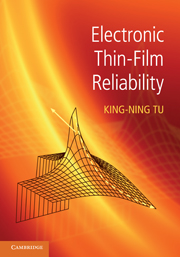Book contents
- Frontmatter
- Dedication
- Contents
- Preface
- 1 Thin-film applications to microelectronic technology
- 2 Thin-film deposition
- 3 Surface energies
- 4 Atomic diffusion in solids
- 5 Applications of the diffusion equation
- 6 Elastic stress and strain in thin films
- 7 Surface kinetic processes on thin films
- 8 Interdiffusion and reaction in thin films
- 9 Grain-boundary diffusion
- 10 Irreversible processes in interconnect and packaging technology
- 11 Electromigration in metals
- 12 Electromigration-induced failure in Al and Cu interconnects
- 13 Thermomigration
- 14 Stress migration in thin films
- 15 Reliability science and analysis
- Appendix A A brief review of thermodynamic functions
- Appendix B Defect concentration in solids
- Appendix C Derivation of Huntington's electron wind force
- Appendix D Elastic constants tables and conversions
- Appendix E Terrace size distribution in Si MBE
- Appendix F Interdiffusion coefficient
- Appendix G Tables of physical properties
- Index
- References
8 - Interdiffusion and reaction in thin films
Published online by Cambridge University Press: 05 July 2014
- Frontmatter
- Dedication
- Contents
- Preface
- 1 Thin-film applications to microelectronic technology
- 2 Thin-film deposition
- 3 Surface energies
- 4 Atomic diffusion in solids
- 5 Applications of the diffusion equation
- 6 Elastic stress and strain in thin films
- 7 Surface kinetic processes on thin films
- 8 Interdiffusion and reaction in thin films
- 9 Grain-boundary diffusion
- 10 Irreversible processes in interconnect and packaging technology
- 11 Electromigration in metals
- 12 Electromigration-induced failure in Al and Cu interconnects
- 13 Thermomigration
- 14 Stress migration in thin films
- 15 Reliability science and analysis
- Appendix A A brief review of thermodynamic functions
- Appendix B Defect concentration in solids
- Appendix C Derivation of Huntington's electron wind force
- Appendix D Elastic constants tables and conversions
- Appendix E Terrace size distribution in Si MBE
- Appendix F Interdiffusion coefficient
- Appendix G Tables of physical properties
- Index
- References
Summary
Introduction
Modern microelectronic semiconductor devices use layered thin films on Si wafers. Interdiffusion and reaction between two neighboring thin-film layers has been a technological issue from the point of view of yield and reliability of the devices. On a piece of Si chip the size of a fingernail, there are now more than several hundred millions of FETs, each of them with source, drain, and gate contacts. These contacts are typically made of silicides, which are IMCs of metal and Si, and each of the contacts must be the same or have the same electrical properties. Hence, in manufacturing VLSI circuits on a Si chip, the formation of silicide contacts and gates has been a critical processing step. So the controlled formation of silicide by depositing and reacting a thin metal film on a Si substrate has been a very active area of study [1–4]. What is unique in the thin-film interfacial reaction is the requirement of “single-phase formation” [5]. This means that we need to form a specific single-silicide phase in all the contacts and gates. Why it is unique is because of the difference between the reaction in bulk diffusion couples and that in thin-film couples. Multiple phases are formed simultaneously in the bulk couples, but multiple phases are formed sequentially one-by-one in thin films, so we can have single-phase instead of multiple-phase formation in thin-film reactions.
- Type
- Chapter
- Information
- Electronic Thin-Film Reliability , pp. 170 - 191Publisher: Cambridge University PressPrint publication year: 2010
References
- 1
- Cited by



